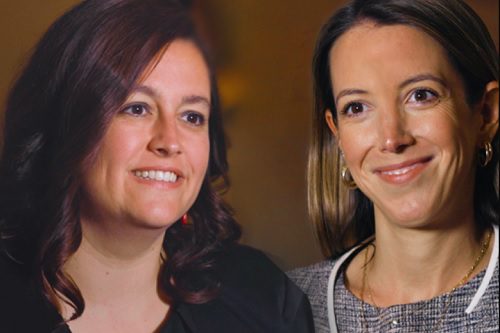How AIG works with private collectors and museums to protect art

AIG’s Muys Snijders (pictured) and Kyle McGrath (pictured) talk about guarding art for future generations.
Art is a vehicle for storytelling, expression, capturing periods of history, portraying cultural milestones, and documenting family ancestry. Properly protecting and preserving artwork for future generations involves diligent planning, maintenance, appraising, recordkeeping, and risk mitigation.
Muys Snijders, Head of Art Collection Management in AIG’s Private Client Group (PCG), and AIG’s art management team utilize their decades of experience in the art world to understand and support the unique needs of private collectors.
“The core of our role at AIG is to help brokers and clients understand what they own and how to protect it,” says Muys, whose art expertise spans her entire career. After studying art history and archeology at Holland’s Leiden University, she spent 20 years leading sales and client strategy at Christie’s Auction House prior to joining AIG in 2021.
She recalls the time when a client needed to send a rare Old Master painting to a museum in Europe for maintenance, including a condition assessment and a conservation treatment. Because the painting was rare and valuable, shipping the fragile item required care and thoughtful planning to help mitigate the risks of damage or loss. As a result, Muys and her team evaluated the museum’s transit plans and protocols, as well as the security protections provided by the museum and conservation studio.
The PCG team review and analyze risk against three different criteria: tracking the market value of the artwork; addressing its exposure to a range of potential vulnerabilities; and factoring where the art is displayed and stored.
Insure to value
Because the valuation of artwork can fluctuate quickly, it’s important for collectors to stay current on their collections’ worth so that items are insured to value. Newly purchased pieces can be appraised at sale price, but a more nuanced understanding of value is needed for longtime collections. For example, if an artist’s work gains popularity and starts selling at higher prices, the team may encourage collectors who already own pieces by that artist to reappraise more often than the typical three- to five-year timeline to document potential rising value.
“It’s a partnership between us and our clients,” says Kyle McGrath, PCG’s Head of Fine Art & Collections, who combines her art history education from Nashville’s Vanderbilt University with her years of underwriting experience to help guide and advise clients on potential risks to their collections.
“We have a fantastic team who work with the insured’s insurance broker to properly schedule art onto the insured’s policy.”
In addition to determining value, the physical aspects of artwork need to be evaluated for risk. Exposure to light, heat, and humidity are all considerations when preserving artwork, especially for older, fragile pieces and mediums requiring specialized care. For instance, works on paper are very delicate, so they need to be regularly rotated to protect them from excess light exposure.
“It’s not always obvious to the naked eye what a piece is made of,” Muys remarks. “The contemporary market uses all types of media, so we encourage collectors to have experts evaluate artwork and make recommendations for its care.”
Location is another key risk. The team looks at their clients’ geographic location to help design emergency plans for weather events and assess if seasonal storage is appropriate. Clients located in hurricane-prone regions, for example, are encouraged to have customized crates on premises to move artwork quickly if a storm approaches. By working with a weather mapping company, the team tracks and monitors storms and may proactively communicate with clients if intervention is needed. Since transporting artwork carries its own damage risk, the team works with specialized transportation companies and storage facilities to avoid damage and other risks when moving fragile works of art. If artwork is damaged, the team, if requested by the client, reaches out to its network of conservators and other experts to quickly help the client relocate the pieces for restoration.
“Those we insure are custodians of art,” Muys says. “We actively contribute to protecting that legacy, which ultimately serves our insureds and their community.”
In addition, part of the underwriting process may involve an onsite visit to assess risk and advise the client of proactive measures to protect and preserve their art. For example, the team looks at proximity to features like fireplaces and windows for heat and light exposure and how pieces are secured to avoid breakage. Understanding a clients’ lifestyle – activity in the residence, if children or pets are present – is a top consideration in creating a plan that not only protects the artwork but allows collectors to live comfortably while enjoying it.
“We look at everything from true property underwriting to an innate understanding of the art itself,” Kyle explains. “We evaluate the environment where the art is kept and help identify vulnerabilities to mitigate risk.”
Bringing artwork to the community
The team’s expertise goes beyond helping clients protect their collections and includes access to a network of art experts, museums, and art galleries to help assist clients who wish to publicly display some of their most prized items.
By working in collaboration with the receiving museum’s registrar, conservators, security team, and curators, the team helps mitigate risks related to everything from transporting to exhibiting the artwork.
“It’s mutually beneficial to collaborate with museums and institutions,” Muys says. “We usually all learn something new about protecting art.”
AIG also partners with museums and institutions by sponsoring exhibits and community-based art programs. These partnerships help amplify voices in the art world – bringing to light artists, artwork, and diversity initiatives that may otherwise remain obscure.
“Giving back to the communities we serve is a top priority at AIG,” says Muys. “We support efforts to give people of all socio-economic backgrounds the opportunity to appreciate art.”
Recently, AIG made a donation to the Baltimore Museum of Art (BMA) in Maryland, which featured a first-of-its-kind exhibit, Guarding the Art, this year. The exhibit was put together by guest curators from the museum’s security department, who collaborated with the museum’s curatorial, design, education, conservation, and marketing teams.
“I think one of the reasons the exhibit has been so successful is that until this point, art curation was something done behind the scenes,” says Alex Dicken, BMA guest curator. “Visitors were very interested in seeing the pieces we chose and hearing why we chose them.”
AIG’s partnerships with museums and institutions, such as the BMA, allows the team to engage with the art community on another level, elevating relationships, and broadening networks with experts in the field.
“What’s wonderful about our work is that we actively contribute to protecting art so it can be enjoyed today and preserved for years to come,” Muys adds.
Special thanks to the Baltimore Museum of Art for opening its doors to AIG for this feature.
Authored by AIG





